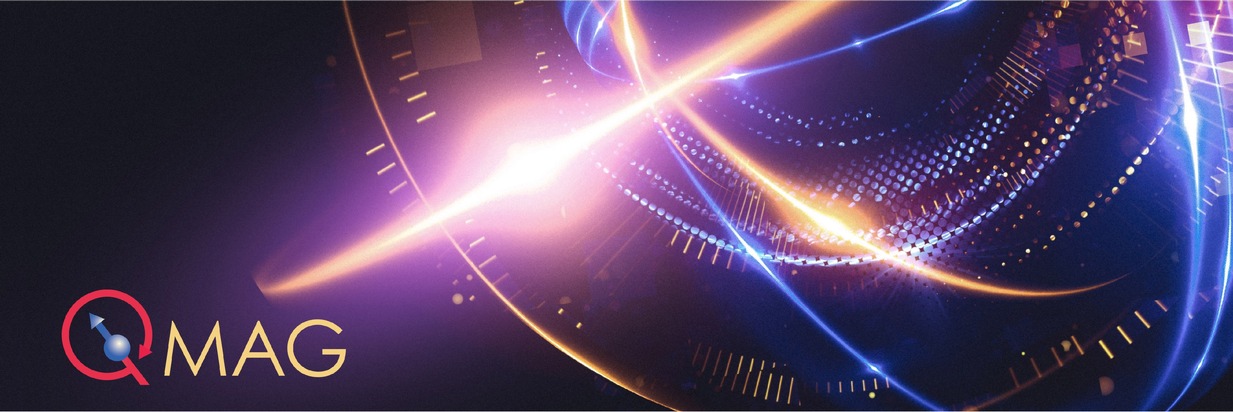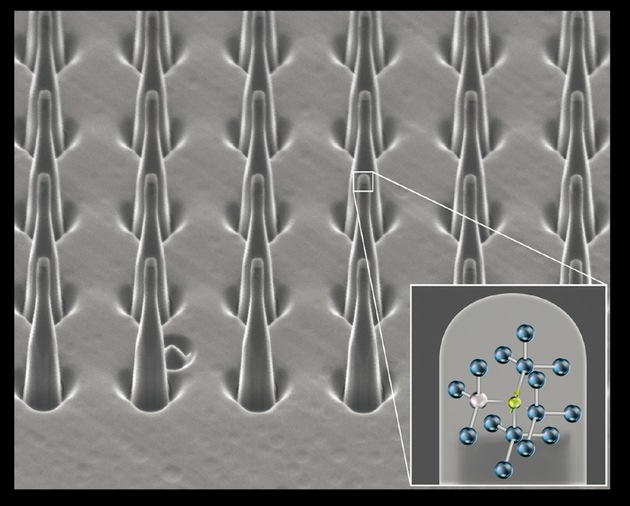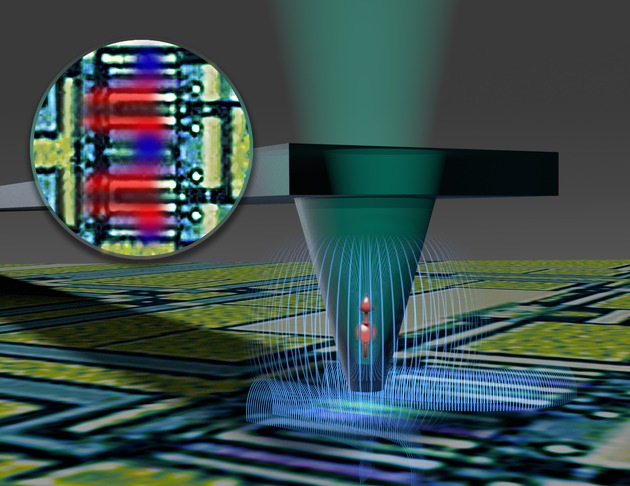Fraunhofer Institut für Angewandte Festkörperphysik IAF
Quantum Magnetometers for Industrial Applications
On April 1 2019, the Fraunhofer-Gesellschaft launches the lighthouse project "Quantum Magnetometry" (QMag): Freiburg's Fraunhofer institutes IAF, IPM and IWM want to transfer quantum magentometry from the field of university research to industrial applications. In close cooperation with three further Fraunhofer institutes (IMM, IISB and CAP), the research team develops highly integrated imaging quantum magnetometers with highest spatial resolution and sensitivity.
The lighthouse project QMag enables the use of single electrons to detect smallest magnetic fields. This allows to use magnetometers in industry, for example for defect analysis of nanoelectronic circuits, for the detection of hidden material fissures or to realize especially compact magnetic resonance imaging scanners (MRI). "Our lighthouse projects set important strategic priorities to develop concrete technological solutions for Germany as an economic location. QMag paves the way for a Fraunhofer lighthouse in the field of quantum technology. The ambition of the excellent scientists who take part in the project is to significantly improve the technology and to define it internationally. In this way a long-term transfer of the revolutionary innovations of quantum magnetometry to industrial applications can be achieved", explains Fraunhofer President Prof. Reimund Neugebauer.
The project QMag runs until 2024 and is founded with a total of EUR 10 million euros in equal parts by the Fraunhofer-Gesellschaft and the federal state of Baden-Württemberg. The Fraunhofer Institute for Applied Solid State Physics IAF, the Fraunhofer Institute for Physical Measurement Techniques IPM and the Fraunhofer Institute for Mechanics of Materials IWM form the core team of the QMag consortium. "The combination of the project partners is an exceptionally unique feature of QMag. This makes Freiburg the leading research location for industrially used quantum sensors - not only in Baden-Württemberg, but throughout Germany", says Dr. Nicole Hoffmeister-Kraut, Minister of Economic Affairs in Baden-Württemberg. Fraunhofer IAF is responsible for the overall coordination of the lighthouse project.
From classical to quantum magnetometry
Magnetometry has two general aims: measuring magnetic fields highly precisely and on the smallest scale. Magnetometers have been used intensively for a long time - as compasses to measure the earth's magnetic field, for geological studies or to analyze nanostructured magnetic layers in hard drives for data storage. There have been numerous breakthroughs in the scientific and technological use of magnetic fields during the past decades, yet the detection of smallest magnetic fields with highest spatial resolution at room temperature has proven to be a great scientific challenge.
To date, existing magnetic sensors are of limited use for industrial applications due to their high costs and the technical effort required, such as cooling. Especially for the imaging of fields created by only a few moving electrons, existing magnetometers are not sensitive enough at room temperature and do not possess the required spatial resolution.
Two complementary systems to tackle the challenges
The QMag consortium has set itself the goal of bringing quantum magnetometry from laboratory to application and making it usable in industry. In order to do so, the Fraunhofer Institutes will develop two complementary magentometers which are able to measure smallest magnetic fields and currents with highest spatial resolution, respectively highest magnetic sensitivity, at room temperature.
More specifically, the project partners aim to demonstrate and test two systems, which are based on the same physical measuring principle and method but which target different applications: On the one hand, a scanning probe magnetometer based on NV centers in diamond will allow highest precision measurements of nanoelectronic circuits. On the other hand, measuring systems based on highly sensitive optically pumped magnetometers ("OPMs") for applications in material probing and process analysis will be realized.
Nanoscaled magnetometry based on NV centers
A scanning probe magnetometer is able to measure magnetic fields with highest spatial resolution at room temperature. The magnetometer consists of single atomic vacancy complexes in diamond crystals which function as the smallest possible magnet. A nitrogen vacancy center ("NV center") in diamond plays the central part. An NV center develops when two neighboring carbon atoms are removed and one is replaced with a nitrogen atom. The resulting vacancy is then occupied by the spare electron of the nitrogen atom. This electron possesses a magnetic momentum, which, after being oriented, can be used as a magnet for the magnetic field that is to be measured. Within Qmag, an NV center will be placed in the nanoscaled tip of a diamond measuring head. When this sensor tip is being moved across a sample within a scanning probe microscope, local magnetic fields can be measured with extremely high spatial resolution. In this manner the electricity distribution in nanoelectronic circuits can be made visible, considering that even the smallest electronic current produces a magnetic field that can be visualized using the quantum magnetometer.
"Our aim is to develop quantum magnetometers with exceptional sensory characteristics, compactness and mode of operation, which allow innovative industrial applications, and furthermore simplify the evolution of complex electronic systems in the future", says Prof. Dr. Oliver Ambacher, project manager and director of Fraunhofer IAF.
OPMs for chemical analytics and material testing
The second sensor system of QMag uses the magnetic field dependency of electronic transitions in alkali atoms: optically pumped magnetometers ("OPMs") are a category of sensors that are being used to measure extremely weak magnetic fields. Just as NV centers, OPMs do not require extreme cooling and are therefore qualified for industrial use. The focus of the scientific work of QMag lies on the development of complete measuring systems based on existing magnetometer prototypes.
In OPMs alkali atoms in the gas phase are prepared with the help of a circular polarized laser beam so that all their magnetic moments have the same orientation. Inside the measured magnetic fields the magnetic moments experience a synchronous precession that can be measured via the absorption of a laser beam of adequate wavelength. The measurement can be done with such a high precision that even magnetic fields of femto-Tesla range are detectable - which is approximately the size of magnetic fields that our brain waves produces while we think. Due to their sensitivity, OPMs can be used as detectors for nuclear magnetic resonance signals ("NMR"). "In QMag, we develop complete measuring systems based on existing single sensor prototypes, which opens up innovative application scenarios, especially in the field of low-field NMR for chemical analytics and material testing", explains Prof. Dr. Karsten Buse, director of Fraunhofer IPM.
Furthermore, the consortium will realize demonstrators for key applications for the mechanics of materials. The magnetic detection of mechanical micro-fissures is a highly sensitive tool for material characterization and component testing and therefore a very relevant field of application. "The high sensitivity of OPM sensors at low frequencies and room temperature opens up completely new application possibilities for material testing. Microscopic material defects can be measured non-destructively on the basis of their magnetic stray field signals", highlights Prof. Dr. Peter Gumbsch, director of Fraunhofer IWM.
Alongside the core team, three additional Fraunhofer institutes contribute their scientific and technological competencies for the development of quantum technological key components. The consortium is completed by the academic expertise of Prof. Dr. Jörg Wrachtrup (University of Stuttgart) in the field of diamond-based quantum technology and by Prof. Dr. Svenja Knappe (University of Freiburg in cooperation with the University of Colorado Boulder) in the field of atom gas magnetometry.
Jennifer Funk Marketing and Communications Fraunhofer Institute for Applied Solid State Physics IAF Tullastrasse 72, 79108 Freiburg, Germany Phone: +49 761 5159-418 jennifer.funk@iaf.fraunhofer.de www.iaf.fraunhofer.de


